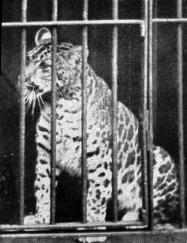|
| Query: Cougar | Result: 252nd of 494 | |
Pumapard (Puma-Leopard Hybrid) - Wiki
| Subject: | Pumapard (Puma-Leopard Hybrid) - Wiki
| |

| Resolution: 187x243
File Size: 11962 Bytes
Upload Date: 2007:09:15 21:19:17
|
ERROR : Server Busy(-1105)
ERROR : Server Busy(-1105)
Pumapard (Puma-Leopard Hybrid) - Wiki
Pumapard
From Wikipedia, the free encyclopedia
[Photo] A pumapard. Photo from 1904. Source: http://members.aol.com/jshartwell/hybrid-bigcats2.html
A pumapard is a hybrid of male Puma and female Leopard or of female Puma and male Leopard. Three sets of these hybrids were bred in the late 1890s and early 1900s by Carl Hagenbeck at his animal park in Hamburg, Germany. Most did not reach adulthood. One of these was purchased in 1898 by Berlin Zoo. A similar hybrid in Berlin Zoo purchased from Carl Hagenbeck was a cross between a male leopard and a female puma. Hamburg Zoo's specimen was the reverse pairing, the one in the black and white photo, fathered by a puma bred to an Indian leopardess.
A similar hybrid was reported by Helmut Hemmer. These hybrids had Puma-like long tails and sandy or tawny coats with chestnut Leopard-like markings and Puma-like cheek markings. Another was described as resembling a little grey Puma with large brown rosettes.
In The Field No 2887, April 25th, 1908, Henry Scherren wrote "There was, and probably is now, in the Berlin Garden an Indian leopard and a puma male hybrid, purchased of Carl Hagenbeck in 1908. In his "Guide", Dr Heck described it as "a little grey puma with large brown rosettes." Another hybrid between the same species, but with a puma for sire and a leopard for dam, was recently at Stelingen; it resembled the female parent in form as may be seen From the reproduction from a photograph taken there."
According to Carl Hagenbeck (1951), a male Puma and female Leopard produced a hybrid male cub that was reared by a Fox Terrier bitch at Hagenbeck Tierpark, Hamburg (fostering being normal practice at this time). This male hybrid was intermediate between the Puma and Leopard in colour and pattern, having faint Leopard spots on a Puma-coloured background. The body length was much less than either parent while the tail was long, like the Puma. A further male hybrid from a mating of male Leopard and female Puma was described as a little grey puma with large brown rosettes. Hagenbeck apparently bred these hybrids at the suggestion of an unidentified menagerie owner, however, the hybrids were considered dull and uninteresting. Modern geneticists find them more interesting because the Leopard and the Puma were not considered to be closely enough related to produce offspring.
H Petzsch (1956) mentioned that Puma/Leopard hybrids had been obtained by artificial insemination. H Hemmer (1966) reported the hybrid between a male Indian Leopard (P pardus fusca) and female Puma as being fairly small with a ground colour like that of the Puma and having rather faded rosettes.
The hybrids were additionally reported by CJ Cornish et al (undated), R R??rig (1903), T Haltenorth (1936) and O Antonius (1951),
H Petzsch (1956) mentioned that puma/leopard hybrids had been obtained by artificial insemination.
Appearance
Whether born to a female Puma mated to a male Leopard, or to a male Puma mated to a female Leopard, pumapards inherit a form of dwarfism. Those reported grew to only half the size of the parents. They have a Puma-like long body (proportional to the limbs, but nevertheless shorter than either parent), but short legs. The coat is variously described as sandy, tawny or greyish with brown, chestnut or "faded" rosettes.
One is preserved in the Walter Rothschild Zoological Museum at Tring, England and clearly shows the tendency to dwarfism.
Puma-Ocelot Hybrid
For comparison with the pumapard, a female Puma has also been successfully hybridised with a male Ocelot although the hybrids died due to lack of maternal care. In spite of the size difference, several sets of Puma-Ocelot hybrids were born to the same parents who shared an enclosure in a private collection. A subsequent female Ocelot-Puma cub born to the pair apparently survived and is shown at L'Ocelot-Puma. The surviving hybrid appears to be long-legged and intermediate in size between the parents with brown markings on a sandy background.
http://en.wikipedia.org/wiki/Pumapard
| The text in this page is based on the copyrighted Wikipedia article shown in above URL. It is used under the GNU Free Documentation License. You may redistribute it, verbatim or modified, providing that you comply with the terms of the GFDL. |
|
Comments |
|---|
| | Samuel |
|
| FJB6Qi Hello! I'm Samuel Smith, i'm from Switqerland i and find your site really brilliant! |
^o^
Animal Pictures Archive for smart phones
^o^
|
|
|